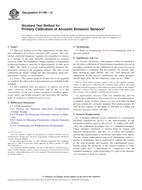Wir benötigen Ihre Einwilligung zur Verwendung der einzelnen Daten, damit Sie unter anderem Informationen zu Ihren Interessen einsehen können. Klicken Sie auf "OK", um Ihre Zustimmung zu erteilen.
ASTM E2191/E2191M-10
Standard Practice for Examination of Gas-Filled Filament-Wound Composite Pressure Vessels Using Acoustic Emission
Automatische name übersetzung:
Standard Praxis für die Prüfung von Gasgefüllte fasergewickeltem Composite-Druckbehälter Mit Acoustic Emission
NORM herausgegeben am 1.6.2010
Informationen über die Norm:
Bezeichnung normen: ASTM E2191/E2191M-10
Anmerkung: UNGÜLTIG
Ausgabedatum normen: 1.6.2010
SKU: NS-44608
Zahl der Seiten: 8
Gewicht ca.: 24 g (0.05 Pfund)
Land: Amerikanische technische Norm
Kategorie: Technische Normen ASTM
Kategorie - ähnliche Normen:
Acoustic measurements and noise abatement in generalPressure vessels, gas cylinders
Die Annotation des Normtextes ASTM E2191/E2191M-10 :
Keywords:
acoustic emission, composite gas cylinders, composite pressure vessel, flaws, gas pressure vessels, NGV tanks, Acoustic emission (AE) testing--metals/metallic materials, Composite pressure vessels, Filament-wound pressure vessels, Gas cylinders, Gas pressure systems/applications, Industrial metals/alloys, Pressure vessels, ICS Number Code 17.140.01 (Acoustic measurements and noise abatement in general), 23.020.300
Ergänzende Informationen
| Significance and Use | ||||||||||||||||||||||
|
Due to safety considerations, the Compressed Gas Association (CGA) and others have produced guidelines which address in-service inspection of NGV fuel containers (see 2.2-2.4). AE examination is listed as an alternative to the minimum three-year visual examination which generally requires that the container be removed from the vehicle to expose the entire container surface. The AE method allows “in-situ” examination of the container. Slow-fill pressurization must proceed at flow rates that do not produce background noise from flow of the pressurizing medium. Acoustic emission data are recorded throughout a pressurization range (that is, 50 % to 100 % of AE examination pressure). Fast-fill pressurization can be used if hold periods are provided. Acoustic emission data are recorded only during the hold periods. Note 1—Fast-fill pressurization is less appropriate for carbon (or graphite) composites due to the lower sensitivity of carbon fibers to stress rupture compared to other fibers. Background noise above the threshold will contaminate the AE data and render them useless. Users must be aware of the following common causes of background noise: high fill rate (measurable flow noise); mechanical contact with the vessel by objects; electromagnetic interference (EMI) and radio frequency interference (RFI) from nearby broadcasting facilities and from other sources; leaks at pipe or hose connections and airborne particles, insects, rain and snow. This practice should not be used if background noise cannot be eliminated or controlled. 5.2 Sensitivity is influenced by factors that affect elastic wave propagation, sensor coupling and signal processor settings. 5.3 It is possible to measure AE from AE sources that cannot be verified by other NDE methods. |
||||||||||||||||||||||
| 1. Scope | ||||||||||||||||||||||
|
1.1 This practice provides guidelines for acoustic emission (AE) examination of filament-wound composite pressure vessels, for example, the type used for fuel tanks in vehicles which use natural gas fuel. 1.2 This practice requires pressurization to a level equal to or greater than what is encountered in normal use. The tanks' pressurization history must be known in order to use this practice. Pressurization medium may be gas or liquid. 1.3 This practice is limited to vessels designed for less than 690 bar [10,000 psi] maximum allowable working pressure and water volume less than 1 m3 or 1000 L [35.4 ft3]. 1.4 AE measurements are used to detect emission sources. Other nondestructive examination (NDE) methods may be used to gain additional insight into the emission source. Procedures for other NDE methods are beyond the scope of this practice. 1.5 This practice applies to examination of new and in-service filament-wound composite pressure vessels. 1.6 This practice applies to examinations conducted at ambient temperatures above 20°C [70°F]. This practice may be used at ambient temperatures below 20°C [70°F] if provision has been made to fill to the tank's rated pressure at 20°C [70°F]. 1.7 Units—The values stated in either SI units or inch-pound units are to be regarded separately as standard. The values stated in each system may not be exact equivalents; therefore, each system shall be used independently of the other. Combining values from the two systems may result in non-conformance with the standard. 1.8 This standard does not purport to address all of the safety concerns, if any, associated with its use. It is the responsibility of the user of this standard to establish appropriate safety and health practices and determine the applicability of regulatory limitations prior to use. Specific precautionary statements are given in Section 8. |
||||||||||||||||||||||
| 2. Referenced Documents | ||||||||||||||||||||||
|
Ähnliche Normen:
Historisch
15.6.2012
Historisch
1.11.2011
Historisch
1.5.2010
Historisch
1.9.2008
Historisch
15.6.2012
Historisch
1.8.2013
Empfehlungen:
EEviZak – alle Gesetze einschließlich ihrer Evidenz in einer Stelle
Bereitstellung von aktuellen Informationen über legislative Vorschriften in der Sammlung der Gesetze bis zum Jahr 1945.
Aktualisierung 2x pro Monat!
Brauchen Sie mehr Informationen? Sehen Sie sich diese Seite an.



 ASTM E1106-12
ASTM E1106-12 ASTM E1110-06(2011)..
ASTM E1110-06(2011).. ASTM E1124-10
ASTM E1124-10 ASTM E1130-08
ASTM E1130-08 ASTM E1139/E1139M-12..
ASTM E1139/E1139M-12.. ASTM E1179-13
ASTM E1179-13
 Cookies
Cookies
